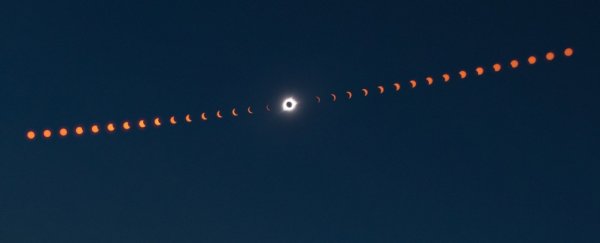The phenomenon of "bow waves" has been long hypothesised, but proven quite elusive. Now, using sensors from 2,000 sites across the US, researchers have what they are claiming is the "first unambiguous evidence" of upper atmospheric bow waves in the wake of an eclipse.
They were seen during the total solar eclipse that spanned coast-to-coast of the US in August 2017, and the detection was the result of a collaboration between MIT's Haystack Observatory and Norway's University of Tromsø.
The Great American Eclipse, as it has come to be known, wasn't just a rare opportunity for many Americans to experience an eclipse within driving distance - it also afforded an opportunity to conduct scientific research using equipment based in America.
The hypothesis that a solar eclipse would produce bow waves in the upper atmosphere was proposed in 1970. According to this idea, as the Moon's shadow is falling onto the atmosphere and moving across the planet with supersonic speed, the temperature dramatically falls.
This rapidly moving shadow causes gravity waves (not to be confused with gravitational waves) in the upper atmosphere - much like a ship makes ocean waves that spread out in its wake.
Since the initial proposal in 1970, several attempts have been made to observe these waves. For starters, a 1973 study was inconclusive.
Microbarographs were used to observe a 1976 eclipse in Australia, and that study produced findings that were consistent with the eclipse bow wave hypothesis. Then, data consistent with eclipse bow waves were observed in 1987 - but neither of these events produced conclusive results.
In 2011, researchers from Taiwan announced they'd actually observed the waves. They used ground-based GPS satellite receivers to track a 2009 eclipse over Taiwan and Japan, looking for changes in electron content - a higher electron count means a higher level of ionisation as electrons get stripped from atoms, creating plasma.
The gravity waves are essentially a higher concentration of plasma in the ionosphere, and can be ascertained by that spike in electron content.
The researchers observed both bow and stern waves, wavelengths between 36 and 120 kilometres (22 and 75 miles), periods of three or five minutes, and travelling through the ionosphere at 100 metres (330 feet) per second.
This is the same technique researchers used to track this year's eclipse - but they had a lot more land available across which to track the shadow, a lot more sensors, and therefore a lot more data.
They observed the waves as electron changes across central and eastern US, with 300-400 kilometre wavelength, periods of around 25 minutes, and travelling at speeds of 280 metres per second - too quickly to be attributed to known gravity wave disturbances we get due to typical ionospheric processes.
The researchers attribute the difference in findings to the limited field of view in a narrow band used by the researchers in the 2011 study.
"This study reveals complex interconnections between the Sun, Moon, and Earth's neutral atmosphere and ionosphere, and demonstrates persistent coupling processes between different components of the Earth's atmosphere, a topic of significant community interest," the researchers wrote in their paper.
They added that their results "present the most comprehensive set of eclipse-induced wave characteristics available to date, advance theoretical understanding, and address a long-standing controversy surrounding one of nature's most spectacular active events."
The research has been published in the journal Geophysical Research Letters.
